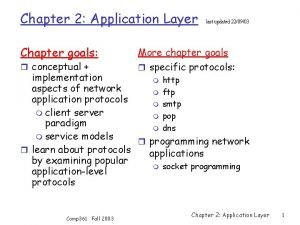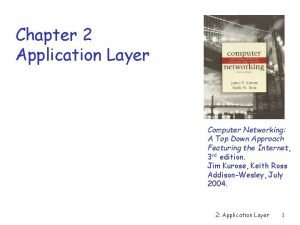Wireless Application Protocol Demand Assignment Protocols Demand Assignment






- Slides: 6

Wireless Application Protocol Demand Assignment Protocols

Demand Assignment Protocols l l l The main objective of demand assignment protocols is to improve channel utilization by allocating the capacity of the channel to contending nodes in an optimum or near-optimum fashion. Unlike fixed-assignment schemes, where channel capacity is assigned exclusively to the network nodes in a predetermined fashion regardless of their current communication needs, demand assignment protocols ignore idle nodes and consider only nodes that are ready to transmit. Polling Reservation

Demand Assignment Protocols l Polling Reservation l

Polling l A widely used demand assignment scheme is polling. In this scheme, a master control device queries, in some predetermined order, each slave node about whether it has data to transmit. If the polled node has data to transmit, it informs the controller of its intention to transmit. In response, the controller allocates the channel to the ready node, which uses the full data rate to transmit its traffic. If the node being polled has no data to transmit, it declines the controller’s request. In response, the controller proceeds to query the next network node.

Polling l The major drawback of polling is the substantial overhead caused by the large number of messages generated by the controller to query the communicating nodes. Furthermore, the efficiency of the polling scheme depends on the reliability of the controller. l The main advantage of polling is that all nodes can receive equal access to the channel.

Reservation l l l The basic idea in a reservation-based scheme is to set some time slots for carrying reservation messages. Since these messages are usually smaller than data packets, they are called minislots. When a station has data to send, it requests a data slot by sending a reservation message to the master in a reservation minislot. In a reservation-based scheme, if each station has its own reservation minislot, collision can be avoided. Moreover, if reservation requests have a priority field, the master can schedule urgent data before delayinsensitive data. Packet collisions can happen only when stations contend for the minislot, which use only a small fraction of the total bandwidth. Thus, the largest part of the bandwidth assigned to data packets is used efficiently.











